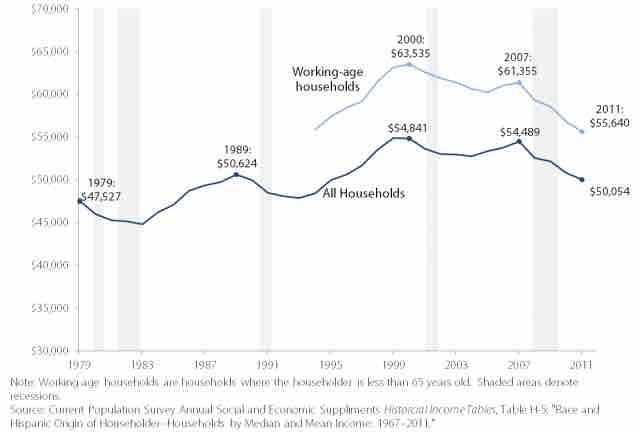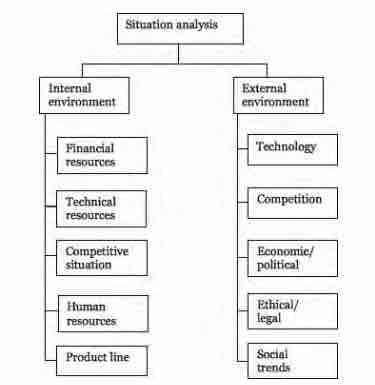Economic Issues
Various economic forces influence an organization's ability to compete and consumer's willingness and ability to buy products and services. The state of the economy is always changing–interest rates rise and fall, inflation increases and decreases. Consumers' ability and willingness to buy changes. Economic changes will affect the demand and supply sides of the market, meaning that the marketer must always be aware of the general economic environment.
The Business Cycle
Fluctuations in our economy follow a general pattern known as the business cycle. These fluctuations in economic conditions affect supply and demand, consumer buying power, consumer willingness to spend, and the intensity of competitive behavior. The four stages in the business cycle are: prosperity, recession, depression, and recovery (see and try to identify the different stages).

Real median household income, 1979-2011
The chart shows the change in household incomes over the last three decades. Shaded areas denote times of recession.
Prosperity
Prosperity represents a period of time during which the economy is growing. Unemployment is low, consumers' buying power is high, and the demand for products is strong. During prosperity, consumer disposable incomes are high, and they try to improve their quality of life by purchasing products and services that are high in quality and price. The U.S. economy was in a period of prosperity from 1991 to 2000. For marketers, opportunities were plentiful during prosperity, and they attempted to expand product lines to take advantage of consumers' increased willingness to buy.
Recession
Recession is characterized by a decrease in the rate of growth of the economy. Unemployment rises and consumer buying power declines. Recession tends to occur after periods of prosperity and inflation. During a recession, consumers' spending power is low, as they are busy paying off debts incurred through credit purchases during more prosperous time. During recessions, marketing opportunities are reduced. Because of reduced buying power, consumers become more cautious, seeking products that are more basic and functional.
Depression
Depression represents the most serious economic downturn. Unemployment increases, buying power decreases, and all other economic indicators move downward. Consequently, consumers are unable or reluctant to purchase products, particularly big-ticket items. Also, consumers tend to delay replacement purchases. Although many marketers fail during this period, insightful marketers can gain market share.
Recovery
Recovery is a complicated economic pattern, in that some economic indicators increase while others may stay low or even decrease. Much of what happens during a recovery may be a result of intangibles, such as consumer confidence or the perception of businesses that things will get better. Tentative marketers take serious risks. Premature marketers may face dire consequences. For marketers, an important task is to attempt to determine how quickly the economy will move into a situation of prosperity. Improper forecasting can lead some firms to overextend themselves, as consumers may be slow to change purchase habits they have been accustomed to in the more difficult economic times.
How Should Marketers React?
The economy is cyclical in nature. We know that the cycles will occur. We just cannot predict exactly when or how severe the cycles will be. Assumptions must be made about money, people, and resources. For example, many organizations become less aggressive when they believe the economy is not going to grow. If they are right, they may do well. If they are wrong, those organizations that are more aggressive can perform very well often at the expense of the conservative organizations. Assumptions must also be made about such economic factors as interest rates, inflation, the nature and size of the workforce, and the availability of resources, such as energy and raw materials. For marketers, the job is to use the information available to make educated predictions about what part of the cycle the economy is in, and best to react to that.
Environmental Scanning
One technique used by organizations to monitor the environment is known as "environmental scanning," which refers to activities directed toward obtaining information about events and trends that occur outside the organization and that can influence the organization's decision making. In a sense, such data collection scanning acts as an early warning system for the organization. It allows marketers to understand the current state of the environment and to predict trends. A formal but simple strategic information scanning system can enhance the effectiveness of the organization's environmental scanning efforts (see for the main internal and external factors). One element of environmental scanning is the general economic environment.

Internal and External factors
Internal and external factors affecting the organization.